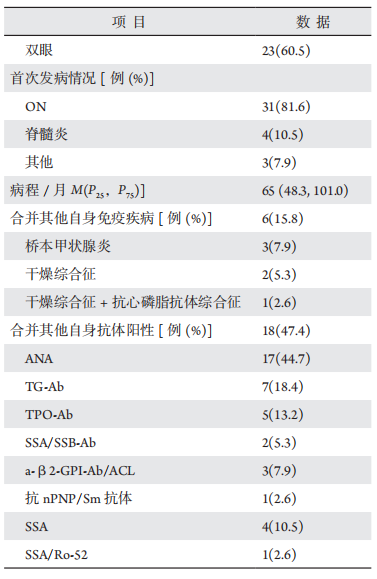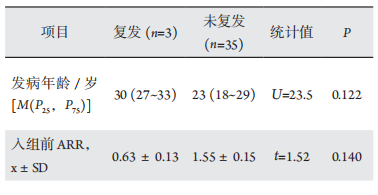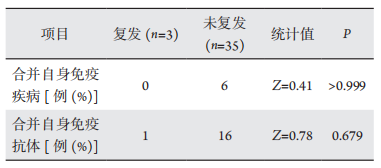1、Sepúlveda M, Armangué T, Sola-Valls N, et al. Neuromyelitis optica
spectrum disorders: comparison according to the phenotype and
serostatus[ J]. Neurol Neuroimmunol Neuroinflamm, 2016, 3(3):
e225.Sepúlveda M, Armangué T, Sola-Valls N, et al. Neuromyelitis optica
spectrum disorders: comparison according to the phenotype and
serostatus[ J]. Neurol Neuroimmunol Neuroinflamm, 2016, 3(3):
e225.
2、Hor JY, Asgari N, Nakashima I, et al. Epidemiology of neuromyelitis
optica spectr um disorder and its prevalence and incidence
worldwide[ J]. Front Neurol, 2020, 11: 501.Hor JY, Asgari N, Nakashima I, et al. Epidemiology of neuromyelitis
optica spectr um disorder and its prevalence and incidence
worldwide[ J]. Front Neurol, 2020, 11: 501.
3、Papp V, Magyari M, Aktas O, et al. Worldwide incidence and prevalence
of neuromyelitis optica: a systematic review[ J]. Neurology, 2021,
96(2): 59-77.Papp V, Magyari M, Aktas O, et al. Worldwide incidence and prevalence
of neuromyelitis optica: a systematic review[ J]. Neurology, 2021,
96(2): 59-77.
4、Holroyd KB, Manzano GS, Levy M. Update on neuromyelitis optica
spectrum disorder[ J]. Curr Opin Ophthalmol, 2020, 31(6): 462-468.Holroyd KB, Manzano GS, Levy M. Update on neuromyelitis optica
spectrum disorder[ J]. Curr Opin Ophthalmol, 2020, 31(6): 462-468.
5、Sadeghpour N, Mirmosayyeb O, Bj?rklund G, et al. Is fertility affected
in women of childbearing age with multiple sclerosis or neuromyelitis
optica spectrum disorder? [ J]. J Mol Neurosci, 2020, 70(11): 1829-
1835.Sadeghpour N, Mirmosayyeb O, Bj?rklund G, et al. Is fertility affected
in women of childbearing age with multiple sclerosis or neuromyelitis
optica spectrum disorder? [ J]. J Mol Neurosci, 2020, 70(11): 1829-
1835.
6、Chang V T W, Chang HM. R ev iew : R ecent advances in the
understanding of the pathophysiology of neuromyelitis optica spectrum
disorder[ J]. Neuropathol Appl Neurobiol, 2020, 46(3): 199-218.Chang V T W, Chang HM. R ev iew : R ecent advances in the
understanding of the pathophysiology of neuromyelitis optica spectrum
disorder[ J]. Neuropathol Appl Neurobiol, 2020, 46(3): 199-218.
7、Gold SM, Willing A, Leypoldt F, et al. Sex differences in autoimmune
disorders of the central nervous system[ J]. Semin Immunopathol,
2019, 41(2): 177-188.Gold SM, Willing A, Leypoldt F, et al. Sex differences in autoimmune
disorders of the central nervous system[ J]. Semin Immunopathol,
2019, 41(2): 177-188.
8、Jarius S, Paul F, Weinshenker BG, et al. Neuromyelitis optica[ J]. Nat
Rev Dis Primers, 2020, 6(1): 85Jarius S, Paul F, Weinshenker BG, et al. Neuromyelitis optica[ J]. Nat
Rev Dis Primers, 2020, 6(1): 85
9、Zhou H, Zhao S, Yin D, et al. Optic neuritis: a 5-year follow-up study of
Chinese patients based on aquaporin-4 antibody status and ages[ J]. J
Neurol, 2016, 263(7): 1382-1389.Zhou H, Zhao S, Yin D, et al. Optic neuritis: a 5-year follow-up study of
Chinese patients based on aquaporin-4 antibody status and ages[ J]. J
Neurol, 2016, 263(7): 1382-1389.
10、Harjunp?? A, Junnikkala S, Meri S. Rituximab (anti-CD20) therapy
of B-cell lymphomas: direct complement killing is superior to cellular
effector mechanisms[ J]. Scand J Immunol, 2000, 51(6): 634-641.Harjunp?? A, Junnikkala S, Meri S. Rituximab (anti-CD20) therapy
of B-cell lymphomas: direct complement killing is superior to cellular
effector mechanisms[ J]. Scand J Immunol, 2000, 51(6): 634-641.
11、Guo Y, Weigand SD, Popescu BF, et al. Pathogenic implications of
cerebrospinal �uid barrier pathology in neuromyelitis optica[ J]. Acta
Neuropathol, 2017, 133(4): 597-612.Guo Y, Weigand SD, Popescu BF, et al. Pathogenic implications of
cerebrospinal �uid barrier pathology in neuromyelitis optica[ J]. Acta
Neuropathol, 2017, 133(4): 597-612.
12、Graf J, Mares J, Barnett M, et al. Targeting B cells to modify MS,
NMOSD, and MO G AD : par t 1[ J]. Neurol Neuroimmunol
Neuroin�amm, 2021, 8(1): e918.Graf J, Mares J, Barnett M, et al. Targeting B cells to modify MS,
NMOSD, and MO G AD : par t 1[ J]. Neurol Neuroimmunol
Neuroin�amm, 2021, 8(1): e918.
13、Jacob A, Weinshenker BG, Violich I, et al. Treatment of neuromyelitis
optica with rituximab: retrospective analysis of 25 patients[ J]. Arch
Neurol, 2008, 65(11): 1443-1448.Jacob A, Weinshenker BG, Violich I, et al. Treatment of neuromyelitis
optica with rituximab: retrospective analysis of 25 patients[ J]. Arch
Neurol, 2008, 65(11): 1443-1448.
14、Cree BC, Lamb S, Morgan K, et al. An open label study of the e�ects of
rituximab in neuromyelitis optica[ J]. Neurology, 2005, 64(7): 1270-
1272.Cree BC, Lamb S, Morgan K, et al. An open label study of the e�ects of
rituximab in neuromyelitis optica[ J]. Neurology, 2005, 64(7): 1270-
1272.
15、Zéphir H, Bernard-Valnet R, Lebrun C, et al. Rituximab as first-line
therapy in neuromyelitis optica: e�ciency and tolerability[ J]. J Neurol,
2015, 262(10): 2329-2335.Zéphir H, Bernard-Valnet R, Lebrun C, et al. Rituximab as first-line
therapy in neuromyelitis optica: e�ciency and tolerability[ J]. J Neurol,
2015, 262(10): 2329-2335.
16、Trebst C, Jarius S, Berthele A , et al. Update on the diagnosis
and treatment of neuromyelitis optica: recommendations of the
Neuromyelitis Optica Study Group (NEMOS) [ J]. J Neurol, 2014,
261(1): 1-16.Trebst C, Jarius S, Berthele A , et al. Update on the diagnosis
and treatment of neuromyelitis optica: recommendations of the
Neuromyelitis Optica Study Group (NEMOS) [ J]. J Neurol, 2014,
261(1): 1-16.
17、Kim SH, Huh SY, Lee SJ, et al. A 5-year follow-up of rituximab
treatment in patients with neuromyelitis optica spectrum disorder[ J].
JAMA Neurol, 2013, 70(9): 1110-1117.Kim SH, Huh SY, Lee SJ, et al. A 5-year follow-up of rituximab
treatment in patients with neuromyelitis optica spectrum disorder[ J].
JAMA Neurol, 2013, 70(9): 1110-1117.
18、Yang CS, Yang L, Li T, et al. Responsiveness to reduced dosage of
rituximab in Chinese patients with neuromyelitis optica[ J]. Neurology,
2013, 81(8): 710-713.Yang CS, Yang L, Li T, et al. Responsiveness to reduced dosage of
rituximab in Chinese patients with neuromyelitis optica[ J]. Neurology,
2013, 81(8): 710-713.
19、Cabre P, Mejdoubi M, Jeannin S, et al. Treatment of neuromyelitis
optica with rituximab: a 2-year prospective multicenter study[ J]. J
Neurol, 2018, 265(4): 917-925.Cabre P, Mejdoubi M, Jeannin S, et al. Treatment of neuromyelitis
optica with rituximab: a 2-year prospective multicenter study[ J]. J
Neurol, 2018, 265(4): 917-925.
20、McLaughlin P, Grillo-López AJ, Link BK, et al. Rituximab chimeric
anti-CD20 monoclonal antibody therapy for relapsed indolent
lymphoma: half of patients respond to a four-dose treatment
program[ J]. J Clin Oncol, 1998, 16(8): 2825-2833.McLaughlin P, Grillo-López AJ, Link BK, et al. Rituximab chimeric
anti-CD20 monoclonal antibody therapy for relapsed indolent
lymphoma: half of patients respond to a four-dose treatment
program[ J]. J Clin Oncol, 1998, 16(8): 2825-2833.
21、Pavanello F, Zucca E, Ghielmini M. Rituximab: 13 open questions a�er
20years of clinical use[ J]. Cancer Treat Rev, 2017, 53: 38-46.Pavanello F, Zucca E, Ghielmini M. Rituximab: 13 open questions a�er
20years of clinical use[ J]. Cancer Treat Rev, 2017, 53: 38-46.
22、Yang Y, Wang CJ, Wang BJ, et al. Comparison of efficacy and tolerability
of azathioprine, mycophenolate mofetil, and lower dosages of rituximab
among patients with neuromyelitis optica spectrum disorder[ J]. J
Neurol Sci, 2018, 385: 192-197.Yang Y, Wang CJ, Wang BJ, et al. Comparison of efficacy and tolerability
of azathioprine, mycophenolate mofetil, and lower dosages of rituximab
among patients with neuromyelitis optica spectrum disorder[ J]. J
Neurol Sci, 2018, 385: 192-197.
23、Li T, Zhang LJ, Zhang QX, et al. Anti-Rituximab antibody in patients
with NMOSDs treated with low dose Rituximab[ J]. J Neuroimmunol,
2018, 316: 107-111.Li T, Zhang LJ, Zhang QX, et al. Anti-Rituximab antibody in patients
with NMOSDs treated with low dose Rituximab[ J]. J Neuroimmunol,
2018, 316: 107-111.
24、Zhao S, Zhou H, Xu Q, et al. Efficacy of low-dose rituximab on
neuromyelitis optica-associated optic neuritis[ J]. Front Neurol, 2021,
12: 637932.Zhao S, Zhou H, Xu Q, et al. Efficacy of low-dose rituximab on
neuromyelitis optica-associated optic neuritis[ J]. Front Neurol, 2021,
12: 637932.
25、Xie L , Zhou H , Song H , et al . Comparative analysis of
immunosuppressive therapies for myelin oligodendrocyte glycoprotein
antibody-associated optic neuritis: a cohort study[ J]. Br J Ophthalmol,
2022, 106(11): 1587-1595.Xie L , Zhou H , Song H , et al . Comparative analysis of
immunosuppressive therapies for myelin oligodendrocyte glycoprotein
antibody-associated optic neuritis: a cohort study[ J]. Br J Ophthalmol,
2022, 106(11): 1587-1595.
26、王均清, 徐全刚, 周欢粉,等. 小剂量利妥昔单抗预防视神经脊髓
炎谱系疾病复发的有效性及安全性观察[ J]. 中华眼底病杂志,
2018, 34(2): 155-158.
WANG JQ,XU QG,ZHOU HF,et al.Efficacy and safety of long-term
treatment with low-dose rituximab for neuromyelitis optica spectrum
disorder[ J]. Chin J Ocular Fundus Dis, 2018, 34(2): 155-158.王均清, 徐全刚, 周欢粉,等. 小剂量利妥昔单抗预防视神经脊髓
炎谱系疾病复发的有效性及安全性观察[ J]. 中华眼底病杂志,
2018, 34(2): 155-158.
WANG JQ,XU QG,ZHOU HF,et al.Efficacy and safety of long-term
treatment with low-dose rituximab for neuromyelitis optica spectrum
disorder[ J]. Chin J Ocular Fundus Dis, 2018, 34(2): 155-158.
27、Waters PJ, McKeon A, Leite MI, et al. Serologic diagnosis of NMO:
a multicenter comparison of aquaporin-4-IgG assays[ J]. Neurology,
2012, 78(9): 665-671;discussion669.Waters PJ, McKeon A, Leite MI, et al. Serologic diagnosis of NMO:
a multicenter comparison of aquaporin-4-IgG assays[ J]. Neurology,
2012, 78(9): 665-671;discussion669.
28、Wingerchuk DM, Banwell B, Bennett JL, et al. International consensus
diagnostic criteria for neuromyelitis optica spectrum disorders[ J].
Neurology, 2015, 85(2): 177-189.Wingerchuk DM, Banwell B, Bennett JL, et al. International consensus
diagnostic criteria for neuromyelitis optica spectrum disorders[ J].
Neurology, 2015, 85(2): 177-189.
29、Damato V, Evoli A, Iorio R. E�cacy and safety of rituximab therapy in
neuromyelitis optica spectrum disorders: a systematic review and meta-analysis[ J]. JAMA Neurol, 2016, 73(11): 1342-1348.Damato V, Evoli A, Iorio R. E�cacy and safety of rituximab therapy in
neuromyelitis optica spectrum disorders: a systematic review and meta-analysis[ J]. JAMA Neurol, 2016, 73(11): 1342-1348.
30、Greenberg BM, Graves D, Remington G, et al. Rituximab dosing
and monitoring strategies in neuromyelitis optica patients: creating
strategies for therapeutic success[ J]. Mult Scler, 2012, 18(7): 1022-
1026.Greenberg BM, Graves D, Remington G, et al. Rituximab dosing
and monitoring strategies in neuromyelitis optica patients: creating
strategies for therapeutic success[ J]. Mult Scler, 2012, 18(7): 1022-
1026.






